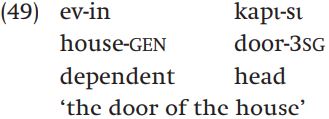
Head- versus dependent-marking
 المؤلف:
Rochelle Lieber
المؤلف:
Rochelle Lieber
 المصدر:
Introducing Morphology
المصدر:
Introducing Morphology
 الجزء والصفحة:
135-7
الجزء والصفحة:
135-7
 24-1-2022
24-1-2022
 1853
1853
Head- versus dependent-marking
Above, we have looked at the morphologies of languages in terms of the ease with which words can be segmented and the relationship between meaning and form in morphemes. There are other things we can look at, however, in classifying and comparing languages.
One thing we can look at is the way that morphology signals the relationship between words in phrases. The main element in each syntactic phrase is called its head; the head of a noun phrase (NP) is the noun, the head of a verb phrase (VP) is the verb, and so on. The other elements that combine with the head to become a phrase might be called the dependents of the head. Dependents of a noun can be adjectives, determiners, or possessives, and dependents of a verb can be its subject or object. Languages can choose to mark relationships between the head and its dependents in different ways: the relationship can be marked exclusively on the head, or exclusively on the dependent, or on both or neither. If the relationship is marked by some morpheme on the dependent, this is called dependent-marking, and if it is marked on the head, it is called head-marking
As illustrated in (46a), the relationship between the head noun and its possessor is marked on the possessor in English, but on the head in Hungarian (46b) (examples from Nichols 1986: 57):


The NP in English therefore shows dependent-marking between a possessor and the head noun, whereas the NP in Hungarian shows headmarking.
Whole clauses may also exhibit either dependent-marking or headmarking. In Dyirbal, NPs are case-marked to show their relationship to the verb:

Dyirbal would therefore be considered a dependent-marking language within clauses.
In contrast, the Mayan language Tzutujil shows head-marking within clauses: the verb is marked for the person and number of its subject and object, but there is no marking on the subject and object themselves to show their function in the clause (Nichols 1986: 61):

As we mentioned above, it is also possible for languages to show neither head-marking nor dependent-marking. For example, a language that is isolating and has no inflection would have neither head- nor dependent-marking. On the other hand, it is possible for a language to have inflectional markings on both the head and its dependents. Turkish, for example, marks both the possessor and the possessed noun in an NP:

When the relationship between the dependent and the head is marked on both constituents, we have what is called double-marking.
 الاكثر قراءة في Morphology
الاكثر قراءة في Morphology
 اخر الاخبار
اخر الاخبار
اخبار العتبة العباسية المقدسة


